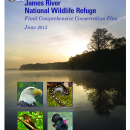What We Do
James Valley National Wildlife Refuge consists of 4,800 acres of pine-dominated, moist hardwood, and floodplain forests; freshwater marsh and shrub swamp; aquatic habitats; erosional bluffs; and non-forested upland. To continue to conserve these habitats, staff conducts management actions including mowing and prescribed fires, chemical and mechanical invasive plant control, and tree plantings to restore former agricultural fields into mixed hardwood forests.
Management and Conservation
Refuges deploy a host of scientifically sound management tools to address biological challenges. These tools span active water management to wilderness character monitoring, all aimed at ensuring a balanced conservation approach to benefit both wildlife and people. At this field station our conservation tool box includes:
Planning – Comprehensive Conservation Plan:
The purpose of a comprehensive conservation plan (CCP) is to specify a management direction for the refuge for the next 15 years. The goals, objectives, and strategies for improving refuge conditions—including the types of habitat we will provide, partnership opportunities and management actions needed to achieve desired conditions – are described in the CCP.
Habitat Restoration:
James River National Wildlife Refuge consists of 4,324 acres of pine-dominated, moist hardwood, and floodplain forests; freshwater marsh and shrub swamp; aquatic habitats; erosional bluffs; and non-forested upland. They support native flora and fauna. To continue to conserve these habitats, staff conducts management actions including mowing and prescribed fires, chemical and mechanical invasive plant control, and tree plantings to restore former agricultural fields into mixed hardwood forests.
Natural Resources Management:
The refuge manages its wetlands, forests, and grasslands with a variety of methods. Intensive (mechanical and chemical) and passive (successional and planting) treatments are used to restore and maintain the integrity of these habitats. Through inventory and monitoring, the refuge is able to be knowledgeable of and responsive to threats from non-native species, climatic changes, and outside pressures. Protection of resources of concern are a priority, given their elevated status. Management for those species include time of year restrictions, limited access, and monitoring.
Cultural Resource Management:
As a federal land agency, the refuge has the important responsibility of protecting and conserving cultural resources and landscapes. Protective measures include strict regulations prohibiting relic hunting, limited public access, and erosion control. The rich history of the site offers opportunity for authorized professionals to build knowledge and interpret to a larger audience.
Our Projects and Research
Over-Stocked Pine Plantation Conversion to Pine Savannah (including Longleaf Pine Demonstration Sites) - This forestry management activity involves a variety of partners to accomplish the goal of improved biodiversity in former commercial logging tracts.
Bald Eagle Monitoring – Established for the protection of the bald eagle in 1991, the refuge continues to support the Bald and Golden Eagle Act mandate by ensuring the lands are maintained for minimal disturbance and high quality habitat. Eight eagle nest are currently on the property. Spring and summer shoreline surveys confirm the annual use by our Nation’s symbol. FWS work with the College of William and Mary ‘s Center for Conservation Biology to tract nests, and evaluate trends. A morning survey can produce upwards of 50 individually unique eagle sightings. Such information has been helpful in determining future land acquisitions, use preferences, and production.
Invertebrate Monitoring - A key element for wildlife diversity involves insects. Many species require them to gain sufficient nutrients to survive. In a project with Virginia Commonwealth University a number of years, collections found that the refuge could have as many 10,000 species of beetles, not to mention the thousand of other taxa. Work with DCR’s Natural Heritage program annual surveys have been monitoring for use of the Frosted Elfin a butterfly species that uses Lupine to lay eggs. This endangered species utilizes area in VA.
Breeding Bird Surveys- Annually survey work is completed during the Spring months to evaluate presence of bird species within a variety of point location, spread within varied habitats. This survey can define trends and underline if management activities (I.e. Pine thinning, prescribed burning) is meeting its goals.
Law Enforcement
The Refuge Complex is patrolled by a Federal Wildlife Officer. Please report all wildlife crimes by calling 804-333-1470 ext.111 or contact the Virginia Department of Wildlife Resources at 800-237-5712. Please provide as much information on the crime as possible. You may remain anonymous.
Laws and Regulations
James River National Wildlife Refuge no longer requires reservations to access the 1.5 mile Powell's Creek nature trail. For all other uses of the Refuge, please submit a reservation four business days in advance of the proposed visit. Requests can be made at (804) 829-9020
